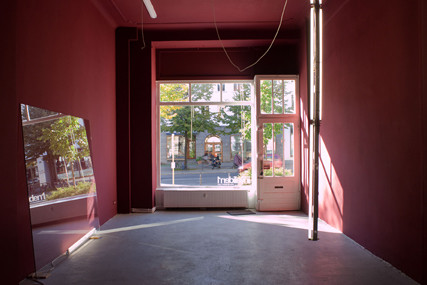Pedro Cabrita Reis
09 Oct - 20 Nov 2010
PEDRO CABRITA REIS
"Ein kleiner roter Raum mit drei Fenstern"
Opening Friday, 8th October // 7pm
Exhibition October 9th - November 20th 2010
Since the early 1990s, Cabrita's work has revolved around the themes of housing, habitation, construction and territory. Along with artworks based on elements of everyday life, such as tables and chairs or doors and windows, he creates expansive installations that fill entire exhibition spaces with both complex and restrained structures. He counters the classic white cube with his use of mere color, massive brick walls, found objects and prefabricated industrial materials such as florescent tube lights, steel girders or aluminum profiles.
Cabrita's use of architectural details and fragments, of building elements and materials, implies that he is particularly interested in a dialogue with architecture. His works do not however address architecture in the sense of planned urban space; his subject is the housed and the ‘Unbehaustheit'. He insists, that "[...] architecture is far from being a source of inspiration to me. What really challenges me is the endless complexity of the primordial and yet ever-present (eternal?) human act of constructing. Architecture comes much after this founding gesture of humanity." Housing, in its wholly existential sense, has been the central subject of Cabrita's work since the beginning.
For Cabrita however, the creation of a home necessarily includes the landscape. Over the past few years he has planted over a hundred olive trees on his land in the bare hills behind Tavira; he has dug boreholes for water and systematically cultivated the land. "To plant these olive trees, these fig trees, the carob trees, is part of me in a very deep way," he says in a discussion with sociologist Augusto M. Seabra and architect Eduardo Souto Moura. The roots of his art, which can continually be felt and seen in his work - in the landscape, in the mentality of his country, its geography and climate along with its long and varied history - are expressed directly here: "[...] I go along my way through the world like Tarkovsky's Rubliov, seeing, listening, feeling, smelling all around me and my art lives off that, even is if by the end of the day the result may be an apparently simple monochrome, or a box with a light, or a brick wall."
Born in Lisbon in 1956, Pedro Cabrita Reis has exhibited widely and participated in numerous international exhibitions, including documenta IX in 1992; in 2003 he represented Portugal at the Venice Biennale. Recently he participated in the 10th Lyon Biennale with two large works. In 2009 the Hamburger Kunsthalle presented the most comprehensive retrospective by the artist to date. The show will travel to the Carré d'Art - Museé d'art contemporain de Nîmes this fall, and after to M van Museum Leuven, and further on to the Museu Colecção Berardo in Lisbon next year.
Text by Markus Richter
"Ein kleiner roter Raum mit drei Fenstern"
Opening Friday, 8th October // 7pm
Exhibition October 9th - November 20th 2010
Since the early 1990s, Cabrita's work has revolved around the themes of housing, habitation, construction and territory. Along with artworks based on elements of everyday life, such as tables and chairs or doors and windows, he creates expansive installations that fill entire exhibition spaces with both complex and restrained structures. He counters the classic white cube with his use of mere color, massive brick walls, found objects and prefabricated industrial materials such as florescent tube lights, steel girders or aluminum profiles.
Cabrita's use of architectural details and fragments, of building elements and materials, implies that he is particularly interested in a dialogue with architecture. His works do not however address architecture in the sense of planned urban space; his subject is the housed and the ‘Unbehaustheit'. He insists, that "[...] architecture is far from being a source of inspiration to me. What really challenges me is the endless complexity of the primordial and yet ever-present (eternal?) human act of constructing. Architecture comes much after this founding gesture of humanity." Housing, in its wholly existential sense, has been the central subject of Cabrita's work since the beginning.
For Cabrita however, the creation of a home necessarily includes the landscape. Over the past few years he has planted over a hundred olive trees on his land in the bare hills behind Tavira; he has dug boreholes for water and systematically cultivated the land. "To plant these olive trees, these fig trees, the carob trees, is part of me in a very deep way," he says in a discussion with sociologist Augusto M. Seabra and architect Eduardo Souto Moura. The roots of his art, which can continually be felt and seen in his work - in the landscape, in the mentality of his country, its geography and climate along with its long and varied history - are expressed directly here: "[...] I go along my way through the world like Tarkovsky's Rubliov, seeing, listening, feeling, smelling all around me and my art lives off that, even is if by the end of the day the result may be an apparently simple monochrome, or a box with a light, or a brick wall."
Born in Lisbon in 1956, Pedro Cabrita Reis has exhibited widely and participated in numerous international exhibitions, including documenta IX in 1992; in 2003 he represented Portugal at the Venice Biennale. Recently he participated in the 10th Lyon Biennale with two large works. In 2009 the Hamburger Kunsthalle presented the most comprehensive retrospective by the artist to date. The show will travel to the Carré d'Art - Museé d'art contemporain de Nîmes this fall, and after to M van Museum Leuven, and further on to the Museu Colecção Berardo in Lisbon next year.
Text by Markus Richter

